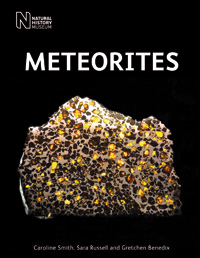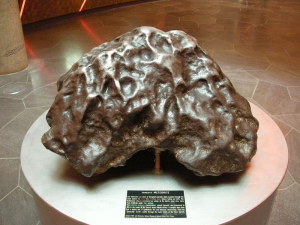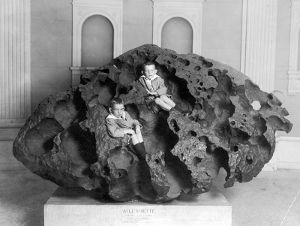Rocks from Space!
Authors: Caroline Smith, Sara Russell and Gretchen Benedix
 As any geologist will tell you, the way to reveal Earth’s history is by looking at the rocks. Tons and tons of rocks. A remarkable amount of information can be obtained by combining a creative and informed mind with a sturdy rock hammer and some well-worn hiking boots. But what if your goal is bigger than that and you want to explain the entire solar system? Remarkably, the answers are still there for the taking – no spaceship required – and Meteorites provides a brief overview of the unassuming rocks that can divulge the many mysteries of our solar system’s origins.
As any geologist will tell you, the way to reveal Earth’s history is by looking at the rocks. Tons and tons of rocks. A remarkable amount of information can be obtained by combining a creative and informed mind with a sturdy rock hammer and some well-worn hiking boots. But what if your goal is bigger than that and you want to explain the entire solar system? Remarkably, the answers are still there for the taking – no spaceship required – and Meteorites provides a brief overview of the unassuming rocks that can divulge the many mysteries of our solar system’s origins.
Drs. Caroline Smith, Sara Russell and Gretchen Benedix – colleagues in the Department of Mineralogy at the Natural History Museum (London) – have teamed up to explore the strange world of meteorites in this beautifully illustrated volume. Before I read this book, I knew that meteorites are rocks that have fallen to earth from outer space, but that was about it. Fortunately, the authors start from the beginning, discussing where meteorites are found, how they are formed, what they’re made of and why they exert such a strong pull on meteorite enthusiasts.
While the geology speak gets pretty thick at times for this reader – who couldn’t begin to tell you the difference between olivine and pyroxene – the accompanying photographs are so stunning that all is forgiven. Some images are as colorful as the stained glass windows in a gothic cathedral. Much of the technical discussion is backed up by useful graphs and diagrams, as well.
But the part of the book that I found most fascinating concerns meteorite origins. Using some remarkably sophisticated techniques, scientists are able to discern where all these rocks – some just a few millimeters in size – come from, dividing them into different categories. Some are former asteroids, wandering astray from the asteroid belt. Others are of moon or Martian origin, the debris left over following massive collisions millions and billions of years in the past. Some even come from comet tails. But maybe most fascinating are a rare few that are older than the sun itself, remnants of the massive cloud that led to our favorite star’s formation, revealing clues about the preceding generation of stars that shone many billions of years ago.
In the end, Meteorites provides a fascinating overview of the remarkable science of extraterrestrial geology, packaged in a gorgeously illustrated book. Strongly recommended for geology and meteorite buffs or for anyone like me who gets a kick out of contemplating the mind blowing story of our vast universe.
— D. Driftless
Tamentit photo by Ji-Elle
Willamette photo by The New York Times (1911)
- Best Non-Fiction of 2016 - February 1, 2017
- Little Free Library Series — Savannah - May 22, 2015
- Little Free Library Series — Wyoming - November 30, 2014





Leave A Comment